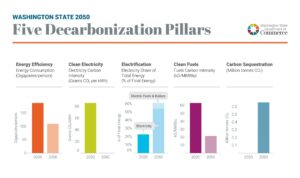Washington State 2023 Energy Report shows significant progress toward clean energy transition, notes key policy and funding opportunities
Climate Commitment Act, first-in-the-nation building performance standards, clean fuel standard among highlights; transmission capacity, equity impacts and workforce offer critical opportunities
OLYMPIA, WA — The Washington State Department of Commerce 2023 Biennial Energy Report documents numerous accomplishments in implementing the State Energy Strategy, including several landmark legislative actions. It also identifies key next steps needed for the state to advance its energy and climate policies and meet the goal of a decarbonized economy by 2050.
“The recent legislative session saw significant progress for implementation of our state’s clean energy policies,” said Gov. Jay Inslee. “This report shows that Washington is on the leading edge of climate and energy nationwide, but this transition away from fossil fuels requires additional work to ensure a clean energy economy everyone can benefit from.”
The report shows the state has made great strides on the State Energy Strategy recommendations on clean electricity, transportation electrification, buildings decarbonization and clean fuels. From the Climate Commitment Act to first-in-nation building performance standards to the adoption of a clean fuel standard, Washington’s policies are spurring an ambitious clean energy transition.
Also detailed are areas where more progress is needed across every sector in order to decarbonize the state’s economy by 2050. Gaps remain in transmission capacity, distributed energy resource deployment, reducing vehicle miles travelled (VMT), decreasing fossil fuel use in residential and commercial buildings, and aligning industrial decarbonization policy with state net-zero emissions goals.
Other key takeaways from the report include:
- Environmental justice. While the state has made progress in advancing environmental justice principles through the Healthy Environment for All (HEAL) Act, it remains critical to examine clean energy policies for equity impacts and provide funding for communities to participate in the clean energy transformation.
- Workforce. There is important work ahead to bolster the state’s clean energy workforce. Supporting workers to ensure they have the skills for clean energy jobs and adopting policies to protect workers in transition is foundational to achieving the state’s energy goals.
- Federal and state funding. In the next decade, there is an unprecedented amount of federal and state funding available that must be used to advance the recommendations in Washington’s State Energy Strategy and the equitable transition to a clean economy, including prioritizing access to clean energy for underserved and overburdened communities.
Read the full Biennial Energy Report
Commerce reports every two years on the status of the State Energy Strategy. This 2023 Biennial Energy Report provides the governor and Legislature an analysis of energy issues affecting Washington residents and businesses, along with an update on recommendations made in the 2021State Energy Strategy

Designed to provide a roadmap for meeting the state’s need for affordable and reliable energy supplies and its greenhouse gas emission limits, the strategy outlines the path to a clean, inclusive energy economy by 2050.
The 2021 State Energy Strategy was developed and published by the State Energy Office at the Department of Commerce, in collaboration with stakeholders and members of the public. Designed to provide a roadmap for meeting the state’s need for affordable and reliable energy supplies and its greenhouse gas emission limits, the strategy outlines the path to a clean, inclusive energy economy by 2050.
###
